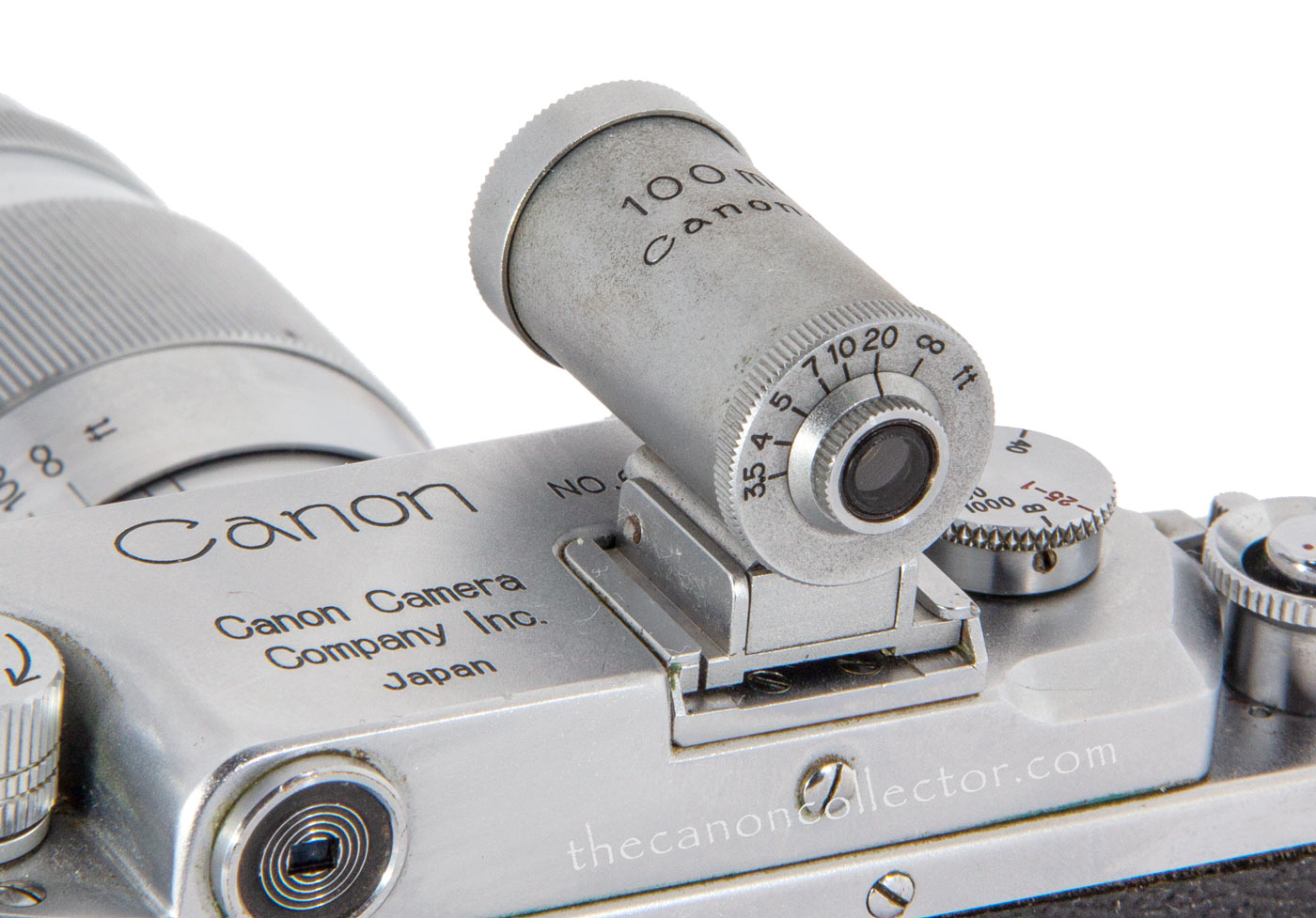My S 100mm 1:4 II (Ser. No. 44679) mounted on my Canon Model IV-S with the 100mm View Finder on top.
S 100mm f/4 II
A Shorter 135 or Longer 90 Lens
The Canon Museum tells us that Canon made two versions of the 100m f/4 lens. They had the same general appearance externally. Kitchingman on the other hand says that he was able to identify six variations of this lens but he tends
to more detail than Canon and
identifies some really minor
variations.
The first of these lenses was introduced
in January of 1948. Canon calls it the S 100mm f4 Serenar I. This name was applied to the first four of Kitchingman’s Types. Types 5 and 6 appear to be the
lens we are discussing here, the S 100mm f/4 Serenar II. Both looked very similar on the outside. The were made of brass with nickel plating. Optically it appears they were identical but structural changes to the Second Version resulted in a much lighter lens.
This second lens type was introduced in April of 1950 and continued in production until July of 1952. Optically it had 3 elements in 3 groups. Minimum aperture was f/22. The filter ring was 34mm in diameter. The changes to internal structure reduced the weight considerably to 355 grams.
There are several ways to tell the two versions apart. The first is by weight. The first version weighed in at 459 grams whereas this version weighed 355 grams. This weight saving was accomplished by a redesign of the internal structure of the lenses.
The second way to distinguish the Second Version is to look at the Distance Scale on lenses calibrated in feet. First Version scale is from 2 to 200 to ∞ feet while the Second Version is from 3.5 to 100 to ∞ feet.
The third way to tell the Second Version is to look for a Serial Number above 43000.
Finally, the Second Version had a rectangular light baffle added after the last lens element which is visible looking into the back of the lens.
The f/stop ring is at the front of the lens barrel and it turns with the focus ring causing problems for accurate focus while changing aperture.
The 100mm f/4 lens came with a 100mm Viewfinder which was superior to the camera viewfinder in most cases with Models II, III and IV.
There was available for the 100mm lens a brown leather case with a strap and a compartment in the lid for the Viewfinder.
So How does it Shoot?
Well, I wish I could report that this was a fantastic lens, but …. it’s not really. But what do you expect from three little pieces of glass?
But, first things first. This lens is looks great and is smooth to operate. The only serious complaint is that the f/stop ring on the front of the lens rotates as you focus the camera and at close distances the f/stop reading is on the bottom of the lens. But that is a minor annoyance.
To see how well the lens creates an image on the sensor I chose a rather poor picture of bare tree branches in the distance from our back yard. Lots of thin lines against a bright background. Now this is a test.
I took the same scene, hand held so they vary a bit, at
f/4, which is wide open on this lens, at f/8 and f/16.
The above image is shot at f/4, the lens wide open. The lower image on the left is from the center of the same image at 100%. On the right is the upper left corner of the image, again, at 100%. You can see that in the center the lens is less than sharp and in the corner it is really really really bad.
The image above is shot at f/8 and, as you can see, the center is not improved that much but the upper left corner is better, but, not that great.
And finally, we have the image above shot at f/16 (what use is f/16, thank you!?). The two lower images are at 100%. Finally the upper left corner is acceptable but neither the center or the corner are really great.
So there you are. You see why I said this is not a great lens. But, again, look at the simplicity of the design. It is hard to believe that Canon expected top performance from this design.
However, really there are no bad lenses, there are just wrong lenses. Some are wrong for most applications. But this lens is soft. Sometimes we spend a lot of effort in Photoshop to create a soft image that gets more soft towards the edges.
I was in the backyard today with this lens on my “R” and I took this image of our cat CoCo. It surprised me. I took a good picture with a not great lens. It may not blow up as well as modern lenses but for 8 x 10 or 11 x 14 is is not bad. And for film in the 1950’s, maybe it was acceptable.
This website is the work of R. Flynn Marr who is solely responsible for its contents which are subject to his claim of copyright. User Manuals, Brochures and Advertising Materials of Canon and other manufacturers available on this site are subject to the copyright claims and are the property of Canon and other manufacturers and they are offered here for personal use only.




















